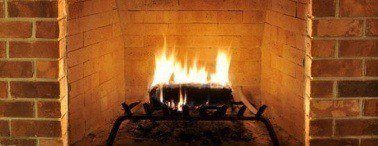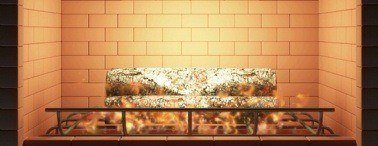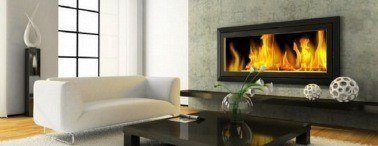
A Traditional Wood Burning Fireplace: Many Considerations
Nothing can compare to the old-world charm of a wood burning fireplace (or a wood stove). There is just something about coming in from a raging winter storm and settling in by a fireplace hearth or wood burning stove that provides a feeling of warmth, comfort, and peacefulness.
However, acquiring a traditional wood burning fireplace poses a rather complex set of considerations, which are essential for building and operating a safe, viable hearth or wood stove:
- A safe firebox: Fireplace construction must be done by a bricklayer or stone mason certified to meet local fire code regulations. Wood stove installation must meet the local codes with firebox firewall elements on the wall behind, and on the floor beneath the stove; such as a brick or stone foundation.
- A safe fireplace chimney or chimney pipe: For a fireplace hearth, the chimney extends beyond the firebox as part of the whole fireplace unit. Fireplace and chimney construction, as well as chimney repair, should done by a certified fireplace builder. For a wood stove chimney pipe, local codes must be met; chimney pipe must meet minimum fire standard specifications, and include extra firewall pipe and fire insulation at penetration points of walls and ceilings.
- Waterproof chimney flashing: One of the most common causes of roof leaks. Whether installing new or replacing chimney flashing for a traditional fireplace chimney or wood stove chimney pipe, the best option is to have an experienced professional do the work. Note: many contractors offer some kind of warranty for their work.
- Regular maintenance: To keep a fireplace chimney or a wood stove chimney operating safely, regular annual inspection and cleaning should be provided by a certified chimney service contractor or chimney sweep. This insures that dangerous creosote buildup and a chimney fire does not occur, or that any damage, break down, or potential fire hazard of the firewall or chimney go undetected.
- The continual need for wood fuel: This entails either purchasing firewood, or cutting and hauling your own. This can demand considerable effort, expense, and time involvement; including gathering, hauling, splitting, and stacking logs. And don't forget carrying it inside from the woodpile. In addition, splitting and stockpiling wood adds another task - cleaning up the mess.
Another consideration for brick or masonry fireplace construction is the fact that a wood burning fireplace lets a huge amount of heat escape up the chimney; providing much less radiant room heat than a wood stove. Up to 90% of all heat generated by a fireplace goes right up the chimney!
Technology Brings Many Alternative Options
Many homeowners with existing fireplaces desiring the enhanced energy efficiency offered by a wood burning stove install a wood stove insert, customized to fit right into the firebox of the fireplace. No additional chimney pipe is necessary; it utilizes the existing chimney.
The most desirable type of wood burning fireplace insert is airtight (a standard feature of most contemporary wood stoves) and offers electric fan-forced air to circulate heat generated in baffles around the firebox into the room. For homeowners not willing to wade through the hassle and regulations that accompany wood stove installation or masonry fireplace construction, as well as the wood fuel issue, there are other increasingly vogue alternatives.
Gas Fireplace
The option of installing a gas burning log into a fireplace has been available for many years; a gas burning appliance (disguised as a wood log) provides a combustion site for the gas, and the fumes are still vented up the chimney. Unfortunately, this concept suffers the same heat loss ratio as a wood burning fireplace.
In more recent years, technology has provided a vent free version of this concept, no chimney required. While this eliminates the need for a chimney, as well as the staggering loss of heat, there are disadvantages. A vent free gas fireplace requires a special burner which cannot be made to look like burning logs. The burner is specially designed to efficiently burn the gas, leaving only a small residual amount of carbon monoxide. If carbon monoxide begins to accumulate to harmful levels in a room, the burner automatically shuts off.
Secondly, burning natural gas as a fuel creates extra moisture. In vented fireplaces, the moisture travels up and out of the chimney with other fumes. In ventless gas fireplaces, the moisture goes into the room, presenting a possible problem with excess moisture.
Electric Fireplace
Another alternative is an electric fireplace insert. When the electric fireplace was first introduced, it was for visual effect; providing no real heat to the room. Today huge assortments of electric fireplace inserts are available, with countless sizes and styles to choose from.
Options range from a complete electric fireplace, an electric fireplace insert, or even an electric fireplace log to place in a traditional fireplace. As well as providing aesthetic appeal, most contemporary electric fireplace models offer up to 10,000 BTUs of clean, efficient heat for a room.
Ventless Gel Fuel Fireplace
The last alternative option is the ventless gel fuel fireplace. Because of the low cost and use of real flame in these type fireplaces, they are becoming extremely vogue and are in high demand. Gel fuel fireplaces are available in countless styles and designs; they use non-toxic isopropyl alcohol gel as a fuel. No vent or chimney is required; no carbon monoxide is produced.
This type fireplace produces both heat and an aesthetically appealing environment. Cost starts at about $300 and up. One disadvantage is that the gel fuel burns quickly; it is relatively high priced, at $80 to $90 for 24 cans.
Locating a Fireplace Contractor
Homeowners opting to build a traditional wood burning fireplace or install a wood stove can find qualified local professionals with the click of a button at TrustedPros.ca. Whether requiring the services of a fireplace chimney contractor, chimney sweeper, or any other type service provider, homeowners can sign up without any cost or obligation whatsoever.
Posted by: TrustedPros





